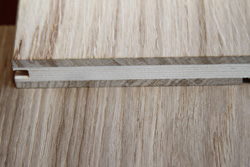
Floating - Hardwood Flooring Installation
Floating engineered flooring installation comes in 2 varieties using either the older traditional tongue and groove system or the new Click Lock system.
Tongue and Groove
 The tongue and groove system will require you to place a bead of glue into the groove of the previous board. Too much glue into the groove will cause some of the glue to squeeze up and out of the seam. If this happens be sure to wipe the glue off immediately with the manufacturer’s recommended removal technique, sometimes just damp paper towel or damp cloth rag will work, but follow the manufacturer’s recommendations.
The tongue and groove system will require you to place a bead of glue into the groove of the previous board. Too much glue into the groove will cause some of the glue to squeeze up and out of the seam. If this happens be sure to wipe the glue off immediately with the manufacturer’s recommended removal technique, sometimes just damp paper towel or damp cloth rag will work, but follow the manufacturer’s recommendations.
Click Lock Systems
The Click Lock design is a somewhat new design that allows you to just click the boards together. This system locks both of the edges together and they hold very securely making for a quick, easy and secure flooring installation. Click locking the boards together alleviates the issues and mess involved with applying too much glue.
There are basically two types of Click Lock engineered flooring available. With one style you will place the board flat and then use a professional tapping block to tap the board into the adjoining board. With the other style you will angle the board into the mating board and press down on the outside edge so it folds down until it snaps into place.
Benefits of a Floating Engineered Hardwood Floor:
- Floating engineered floors are usually the best option when installing over radiant heat.
- Expansion and contraction is a major problem for solid hardwood floors and even for some engineered floors that are nailed or glued down (especially if weather conditions go from one extreme to the other throughout the year). With a floating floor the boards act like a single unit and expand and contract together because they are not attached to the floor.
- Floating floors can be installed in basements
- Floating floors can be installed over other wood flooring, tile and even vinyl.


